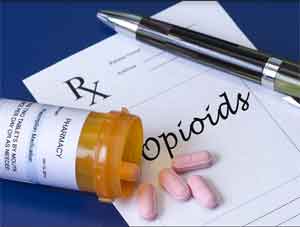- Home
- Editorial
- News
- Practice Guidelines
- Anesthesiology Guidelines
- Cancer Guidelines
- Cardiac Sciences Guidelines
- Critical Care Guidelines
- Dentistry Guidelines
- Dermatology Guidelines
- Diabetes and Endo Guidelines
- Diagnostics Guidelines
- ENT Guidelines
- Featured Practice Guidelines
- Gastroenterology Guidelines
- Geriatrics Guidelines
- Medicine Guidelines
- Nephrology Guidelines
- Neurosciences Guidelines
- Obs and Gynae Guidelines
- Ophthalmology Guidelines
- Orthopaedics Guidelines
- Paediatrics Guidelines
- Psychiatry Guidelines
- Pulmonology Guidelines
- Radiology Guidelines
- Surgery Guidelines
- Urology Guidelines
Abrupt opioid discontinuation can increase suicide risk, warns FDA

The US Food and Drug Administration has released a recent safety communication stating that abrupt discontinuation of opioids or rapid reduction of the dose can do serious harm to patients with a physical dependence on opioid pain medicines. Harmful effects include psychological distress, serious withdrawal symptoms, uncontrolled pain, and increased risk of suicide.
This is based on the ongoing monitoring of the Food and Drug Administration regarding risks associated with opioid pain medicines.
In light of these concerns, the agency has requested to make changes in the prescribing information for these medicines that are intended for use in the outpatient setting.
"These changes will provide expanded guidance to health care professionals on how to safely decrease the dose in patients who are physically dependent on opioid pain medicines when the dose is to be decreased or the medicine is to be discontinued," Food and Drug Administration(FDA) said in a press release.
"Rapid discontinuation can result in uncontrolled pain or withdrawal symptoms. In turn, these symptoms can lead patients to seek other sources of opioid pain medicines, which may be confused with drug-seeking for abuse. Patients may attempt to treat their pain or withdrawal symptoms with illicit opioids, such as heroin, and other substances," the agency further added.
Opioids are a class of powerful prescription medicines that are used to manage pain when other treatments and medicines cannot be taken or are not able to provide enough pain relief. They have serious risks, including abuse, addiction, overdose, and death. Examples of common opioids include codeine, fentanyl, hydrocodone, hydromorphone, morphine, oxycodone, and oxymorphone.
Also Read: FDA approves new dosage of buprenorphine and naloxone for opioid dependence
The letter of Food and Drug Administration recommended that opioid tapering should be tailored to individual patients. Broadly speaking, providers should:
- taper opioid doses by increments no greater than 10% to 25% of a dose every two to four weeks in individuals receiving long-term opioids;
- monitor patients closely and support them during the tapering process to avoid adverse events related to withdrawal; and
- put in place multimodal pain management and psychosocial support before tapering.
Also Read: FDA Panel votes Lofexidine for approval for Opioid Withdrawal
According to Matthew Grissinger, RPh, the director of error reporting programs at the Institute for Safe Medication Practices, in Horsham, Pa., better training is required for clinicians and pharmacists inside and outside of the health system, so they know how to appropriately manage chronic pain, including opioid dosing.
“Unless you have experience discontinuing opioids, or you’ve been trained in pain management, you may not know how to properly taper patients off opioids,” Grissinger said.
Pharmacists can identify patients who may require opioid tapering by taking a detailed history of a patient’s opioid use on admission, he suggested. “We typically obtain a medication list to simply see what a patient may be taking, including whether a patient is opioid-naive or opioid-experienced, but we should actually be considering more than that—the duration of opioid use, dosing changes over the last few weeks, the type of pain they’re being treated for,” Grissinger said.

Disclaimer: This site is primarily intended for healthcare professionals. Any content/information on this website does not replace the advice of medical and/or health professionals and should not be construed as medical/diagnostic advice/endorsement or prescription. Use of this site is subject to our terms of use, privacy policy, advertisement policy. © 2020 Minerva Medical Treatment Pvt Ltd